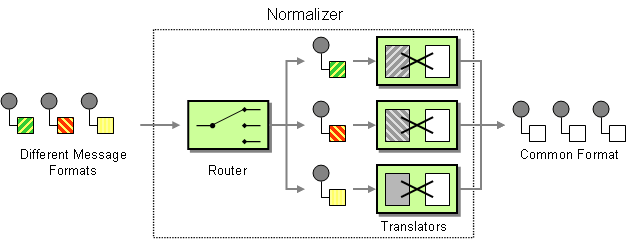9.3. Normalizer
Overview
Copy linkLink copied to clipboard!
The normalizer pattern is used to process messages that are semantically equivalent, but arrive in different formats. The normalizer transforms the incoming messages into a common format.
In Apache Camel, you can implement the normalizer pattern by combining a content-based router, which detects the incoming message's format, with a collection of different message translators, which transform the different incoming formats into a common format.
Figure 9.3. Normalizer Pattern
Java DSL example
Copy linkLink copied to clipboard!
This example shows a Message Normalizer that converts two types of XML messages into a common format. Messages in this common format are then filtered.
Using the Fluent Builders
In this case we're using a Java bean as the normalizer. The class looks like this
XML configuration example
Copy linkLink copied to clipboard!
The same example in the XML DSL
